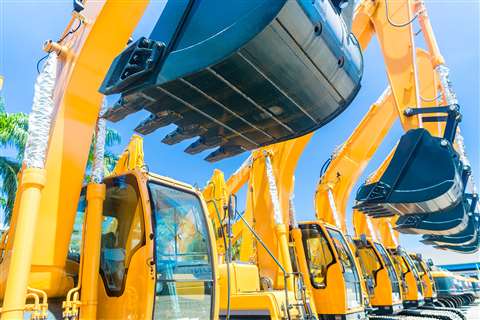What does the future hold for global construction equipment sales?
21 April 2023
 Image: Kzenon via AdobeStock - stock.adobe.com
Image: Kzenon via AdobeStock - stock.adobe.com
The number of units of construction equipment sold around the world hit a peak in 2021, climbing to nearly 1.3 million from fewer than 500,000 two decades before.
But amid an uncertain economic climate, how do they look from now until 2027?
Data from Off-Highway Research for the last two decades show the comparatively strong progress that sales have made over that period.
While the 2008 financial crisis caused a significant drop and there was a slightly less severe dip in 2015-2016, the last few years have been characterised by strong growth, from just under 750,000 units in 2016 to 1.2 million units in 2022.
But following the economic turbulence caused by the Covid-19 pandemic and then the war in Ukraine, Off-Highway Research forecasts a moderate decline in total global sales until 2025, before they start to pick back up again in 2026 and 2027.
Sales in 2023 are forecast to drop to just over 1.11 million units, falling to 1.05 million in 2024, 1.03 million in 2025, then 1.07 million in 2026 and 1.12 million in 2027.
China drags global sales down
The slowdown in global sales over the next couple of years comes amid a steep decline in China between 2020, when sales were on a high of 412,485 units, to 2023 when they are forecast to fall to less than half that, at 193,766.
Nonetheless, Off-Highway Research forecasts a gradual recovery in sales between 2023 and 2027, by which time it expects sales to have climbed back to 270,415.
There are early signs that China’s construction market is returning to normal, with China State Construction and Engineering Corporation (CSCEC) reporting a 27% year-on-year increase in new contracts in January-February 2023, driven by new infrastructure work.
The drop came amid a much-publicised slowdown in the Chinese housing market amid the Covid-19 pandemic and a long cycle of coronavirus lockdowns which only came to an end in December 2022 when China ditched its zero covid policy.
The 7% decline in global sales in 2022, after a high in 2021, was almost entirely due to a collapse in sales in China.
Off-Highway Research predicts a further 7% decline in global sales in 2023 and once again, it is the weakness of the Chinese market driving the decline. Stripping out China, the remaining countries of the world would only see a 5% decline.
Equipment sales in China over the last 20 years have been marked by significant peaks and troughs.
The first peak came in 2010 and 2011 when sales rose to 401,207 units and 434,650 units respectively, driven by a huge US$585 billion government stimulus package to boost construction after the global financial crisis.
Much of the money went towards physical infrastructure, particularly a high-speed rail network. That led to a huge spike in equipment sales in 2010 and 2011.
The stimulus meant that China had a huge fleet of new machines, leading to a precipitous drop in sales that bottomed out at around 120,000 units in 2015 and 2016.
Sales then picked up again rapidly with the arrival of the One Belt One Road initiative in the late 2010s.
North America plots a steadier course
By contrast, sales in North America have plotted a steadier upward trend from a low-point in 2009 of just 77,430 units in the aftermath of the 2007-2008 financial crisis, to nearly 319,000 units in 2021.
However, Off-Highway Research forecasts a tougher environment for sales over the coming years, dipping to 276,100 in 2026 before staging a mild recovery in 2027.
Off-Highway Research managing director Chris Sleight says, “Although a modest 1% decline in sales is expected this year, the market will still enjoy the second-highest volumes ever seen. The long lead times for equipment mean that suppliers are confident of sales well into the third quarter of the year, even though rising interest rates are starting to cool off the housing market.
“While this is expected to lead to a fall in sales of smaller equipment types, infrastructure investment is on the rise in the region, thanks in part to the stimulus plans which were put in place during the pandemic years.
“By their nature, machines used in infrastructure construction are higher value/lower volume than the compact equipment sales which are driven by residential building. This is therefore expected to lead to a shallow dip in sales from 2023-2026. However, North America suffers from a shortage of housing, and this is expected to stimulate an upturn in compact equipment sales towards the end of the forecast period.”
Rest of the world
Sales of equipment in India and Japan have also taken a much steadier course over the past 20 years.
India’s most recent high was in 2018, with the market disrupted in 2019 by a general election, which led to the suspension of the award of public works contracts. The market sank further in 2020 as a result of the Covid-19 pandemic and only recovered modestly in 2021.
But sales in India look set to gradually increase from just under 62,000 in 2022 to 86,700 by 2027, as the country works to plug gaps in its infrastructure as it focuses on growing into a US$5 trillion economy.
Unfortunately, another election next year will temporarily derail growth and there will be further market-specific disruption due to the introduction of CEV Stage-V emissions laws in April 2024. However, Off-Highway Research remains bullish about the medium and long-term growth prospects in the Indian market, and expects equipment sales to resume their ascent from 2025 onwards.
Meanwhile, sales in Europe look set to remain relatively flat. While work to transition to new forms of energy generation is helping to stimulate infrastructure, the ongoing land war between Ukraine and Russia is causing higher inflation that is dragging on European economies.
The strongest growth in 2022 was seen in the larger markets of Southern Europe – most notably Italy, which saw sales rise a 18%, while Spain’s 17% growth was also well above average. France also performed well with an 8% rise in sales, thanks to broad demand for both heavy and compact equipment.
Growth in the UK was more subdued at 4%, but the volume of equipment sold was the highest ever seen. Meanwhile the German market declined 1%, but this must be seen in the context of the extraordinarily high number of machines which have been sold in the country in the last four to five years.
Sleight says, “Off-Highway Research’s forecast for Europe is essentially for the market to stabilise at a high level. Although single-digit percentage annual declines in sales are expected for the next three years, the market is forecast to remain above 200,000 units over the medium term. Prior to the current peak, a volume above 200,000 machines sold was only achieved once before for a single year in 2007.
“A slowdown in housebuilding due to rising interest rates represents a threat to compact equipment sales. However, Europe’s infrastructure markets are strong, which should stimulate sales of larger earthmoving equipment.”
CONNECT WITH THE TEAM





